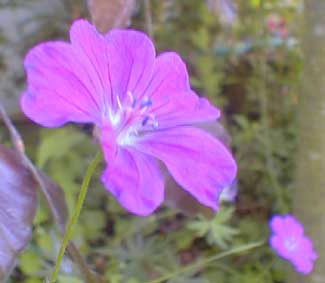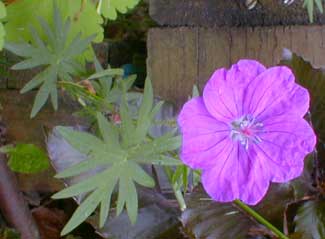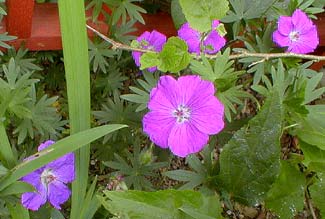
Bloody Crane's-bill
"Frail flowers that arrive with the cuckoo,
Pale lilac, hyacinth purple of hue,
& the little pink geranium,
All smil'd & nodded to see me come;
All gave me welcome; 'No noise,' they said,
'For we will show you the bridal bed.'"
-Roden Berkeley Wriothesley Noel
1834-1894
1834-1894
With purple-pink to purple-red flowers, Geranium sanguineum var sanguineum is native to Great Britain & southern Europe, ranging all the way to northern Turkey.
Although it is not regarded as particularly invasive, it has proven so under preferred conditions, having escaped gardens in sundry places of the world, including New England & the Great Lakes region, to establish itself in the wild.
 With full sun to part shade, & loamy soil with medium moisture, it will require little care to thrive. It is rarely afflicted by pests or disease, but if it is per chance assaulted by black-spot, the whole plant should be cut to the base, the leaves destroyed rather than composted, & the clump allowed to start over.
With full sun to part shade, & loamy soil with medium moisture, it will require little care to thrive. It is rarely afflicted by pests or disease, but if it is per chance assaulted by black-spot, the whole plant should be cut to the base, the leaves destroyed rather than composted, & the clump allowed to start over.A few cultivars of G. sanguineum do have flowers that approach the red or bloody end of the spectrum, though a purply pink is typical. The name "Bloody" Crane's-bill derives not from flower color, but from the vibrant autumn colors of the leaves. Before the clump dies back, it turns wonderful shades of pink & red, looking momentarily similar to Herb Robert.
It is most flowery in late spring & much of summer. Its first blooms usually appear at the tail-end of April, but it really gets going late May & June.
 It can benefit from a good sheering at mid-year when it may have gotten lanky or too sprawly. After a hard sheer, it will grow back rapidly with rebloom in autumn.
It can benefit from a good sheering at mid-year when it may have gotten lanky or too sprawly. After a hard sheer, it will grow back rapidly with rebloom in autumn.Hardy in zones 4 through 8, it completely vanishes in winter & in more northerly gardens it may need protective mulching for the coldest time of year.
On Puget Sound, the leaves return in February. These are deeply cut, almost like miniature delphinium leaves.
It's typically less than a foot tall but with as much as a two to three foot spread. It will occasionally humps up taller, especially if grown under a shrub it can climb up & through.
Three plants in a square yard will provide a complete groundcover smothering weeds, though it's not always as dense a groundcover as a species such as G. macrorrhizum.